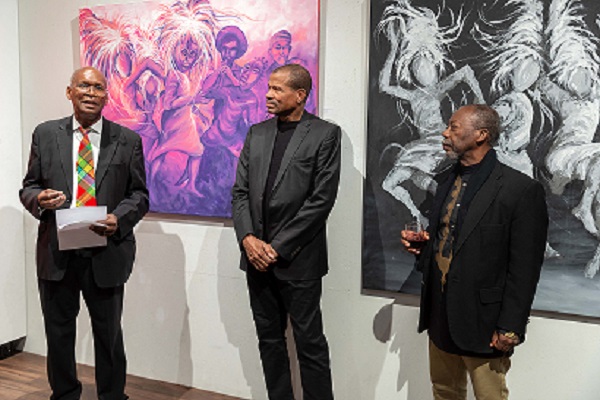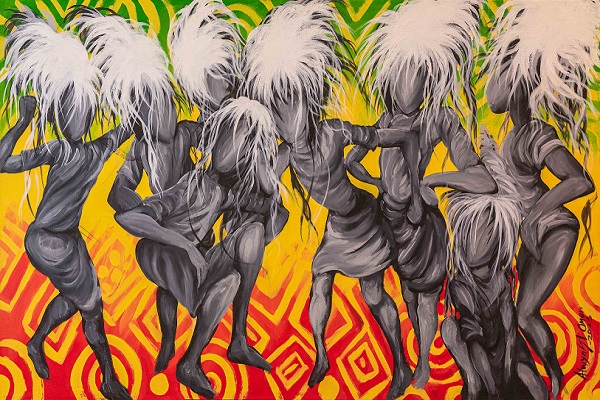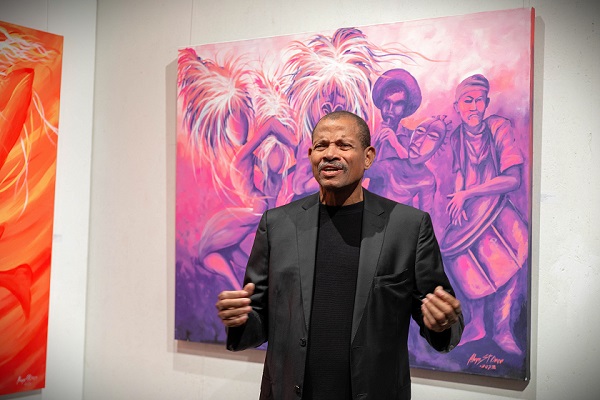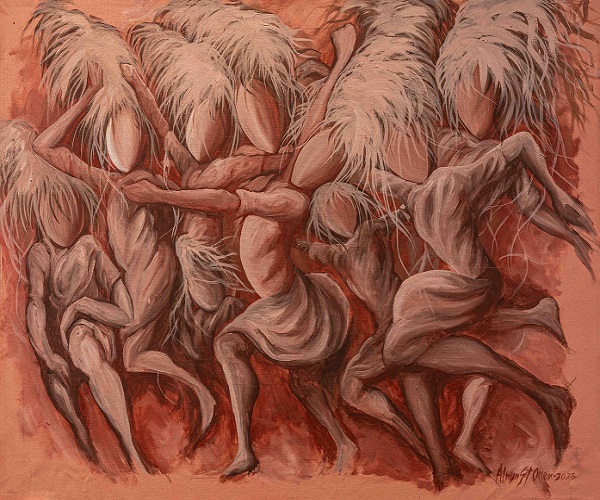While exhibiting his paintings in London, I caught up with renowned Saint Lucian artist, Alwyn St. Omer, and interviewed him on aspects of his artistry and about his recent world premiere exhibition of the Masquerade Moon Dancer Painting Series at the London Lighthouse Gallery and Studio, in East London.
Born in Castries in 1959, St. Omer is a prolific artist, who came from an artistic background. His first influences came from his father, the internationally acclaimed Saint Lucian painter, religious muralist and educator, Sir Dunstan St. Omer, who was responsible for designing the Saint Lucian flag.
His father painted at night and the young St. Omer became enthralled by the smell of the paints and the colours on the canvas, thus igniting his desire to paint from an early age. His parents also had a huge library of books on African culture, history and mythology, as well as books and literature on European and Eastern cultures. Consequently, he and his siblings gained an understanding and appreciation of their African roots, as well as other cultures and peoples. Later, the Franco-phone Creole language, the music and the Saint Lucian culture, all helped in the expansion of his artistic outlook.

Speakers Dr. Morgan Dalphinis and Patrick Anthony, founder of the Folk Research Centre. Photo courtesy Sokari Higgwe
St. Omer’s talents are not limited to painting. He is also a master draughtsman and colourist. He studied graphic art at the Edna Manley School for the Visual Arts in Jamaica and video production and audio visuals at Portsmouth College in England. He has a very impressive artistic CV that includes painting in acrylics and oils. He is also proficient in painting wall murals. His paintings are in numerous collections: locally, regionally and internationally. His collections are owned by prime ministers, art collectors and recently, the vice chancellor of UWI, professor, Sir Hilary Beckles. Others’ who own his painting also include: The High Commissioner of the Bahamas; The Archbishop of Saint Lucia, and Prince Edward and his wife; The Countess of Wessex.
His brilliant draughtsmanship skills enabled the design of the National Independence Monument of Saint Lucia. His creativity has also found outlets in the publishing of children’s books and comics, including Soucoyan, a graphic novel on Saint Lucian mythology. He was also a carnival costume designer and bandleader of La Mosaique Carnival Band.
Married with five children, St. Omer is an impressive artist and technical planner who express his talents in many different art forms.
Heavily influenced by his Saint Lucian roots, he has managed to capture the quintessential elements of the island’s cultural and artistic identity in works that are vibrant, and which expose the viewer to a wider cultural awareness.
In his principal series, currently of 24 pieces (and expanding), St. Omer pays homage to the masquerades that were once performed as street theatre during the Christmas period when he was growing up in Castries, during the 1960’s and early 1970’s. St. Omer sadly remembers the tradition strangely disappearing in the mid 1970’s, the time of the last Toes or Papa Djab.
Nonetheless, St. Omer, in his Moon Dancer series, immortalises the masquerade while memorialising the resilience of West African enslaved people. This tribute to the resilience and survival of enslaved Africans also carries a powerful message today. It connects many ancient and current cultural practices from various West African cultures, to that of the African Diaspora. In turn, that acts as a force for understanding, education and reconciliation between the two.
St. Omer recollects that the Moon Dancer masquerade thus emerged as series of abstract paintings created to save the lost masquerade tradition of Saint Lucia in painting. This attempt to preserve an ancient tradition led him to discover, that masquerades were actually ritualistic gifts from the African past; a tradition emanating from secret acts of slave rebellion in the plantation system.
Whenever the plantation owners permitted any form of celebration from their daily misery, enslaved people would revert to the traditional forms of their masking tradition. Thus rein-acting a quiet revolution and secret link to the motherland, from whence they were so savagely torn. It was a silent conquest over those who sought to be their masters; those ritualistic gifts provided quiet comfort to the enslaved, soothing the pain in their hearts.
St. Omer theorises that the Moon Dancer pieces can be interpreted as a universal symbol of survival against systemic racism and various forms of oppression.
Looking at the masked figures in the Moon Dancer series, there is a feeling of mystery and trepidation of the unknown. The figures are united in wild contortions of the body; perhaps reminiscent of a time when the enslaved were free to abandon their shackles momentarily through dance. Nonetheless, it is equally easy to see how the faceless dancers and the fluidity of their body movements could evoke terror in children.
The Saint Lucian masquerade characters in the early 1960’s contained various symbolic characters that could be colourfully mesmerizing yet frightening. The procession was lead by Toes or Papa Djab, the all-powerful leader who wore a mask with horns on his head; he was dressed in red and his face was painted white with a long beard. There was his pregnant wife, Mary Ansèt and also the Ti Djabs or little devils who blindly followed Papa Djab, to do his bidding. There was also Kabwit a goat-like creature with a calabash horned headdress, whose costume was made from crocus bags. Another interesting but frightening masquerader was the Pie Banan, whose costume was made from dry banana leaves. With such a motley crew, it is easy to understand the fear, magic and mystery that such performances would conjure up, and why sometimes even the young St. Omer refused to be an onlooker in those festivities.
Today, the Moon Dance is still performed under the light of the moon, in a ritualistic dance of rebellion and redemption by secret societies in the African Diaspora and in parts of West Africa.
Noticing the passion and conviction with which he spoke of his Moon Dancer series, I asked him what was his favourite piece of work, to which he philosophically replied that asking that question, would be like asking him which of his children was his favourite. Like all artists, their work is a labour of love and it is hard to differentiate which is best, because they are all a part of the artist’s energy and passion expressed at different times.
Pleased by the positive reception of his recent exhibition in London, St. Omer would like his paintings to reach, and be a source of inspiration to a more cosmopolitan audience.
The artist has been awarded the Saint Lucia Medal of Honour, Gold, for eminent service rendered in the field of Art and Culture (2021) and is a double Catapult Caribbean Art awardee.
The Moon dancer Exhibition: The Lighthouse Gallery and Studio was held September 16th-30th 2023









1 comment
Endearing, and enlightening article
that makes both the artist, Alwyn St. Omer and the Moon dancers weave their mystery of the masqueraders. Fascinating.
PCW